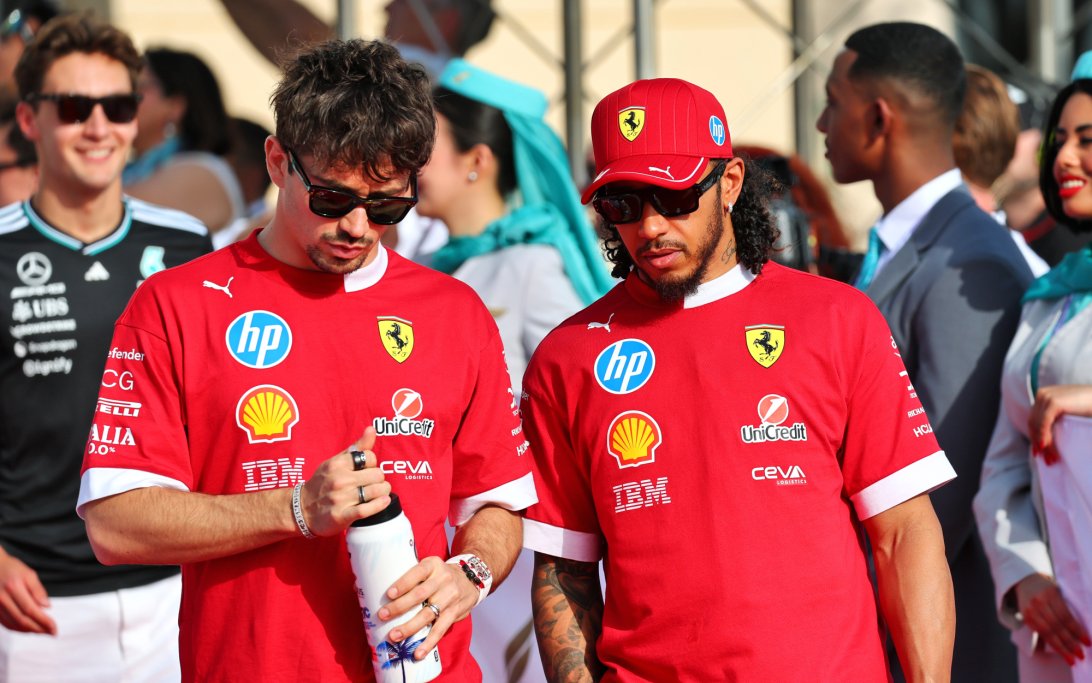For fourteen races, the motorsport world has held its breath, watching one of its greatest titans, Lewis Hamilton, grapple with a reality few could have ever predicted.
The celebrated move to the iconic scarlet of Scuderia Ferrari, hailed as the crowning chapter of a legendary career, has so far been a chronicle of frustration and unfulfilled potential. Zero podiums. Inconsistent pace. A palpable sense of struggle.
The whispers grew louder with every race weekend: Had the seven-time world champion lost his touch? Was the pressure of Maranello too immense? Or was this simply the painful, protracted decline of a giant?

The truth, as it turns out, is far more complex and alarming. A recent in-depth analysis has unearthed a “sinister” issue, a fundamental flaw not in the driver, but deep within the technological heart of Ferrari itself. It reveals that Hamilton has not been battling his rivals on equal terms. Instead, he has been fighting his own car, unknowingly handicapped by a system that was supposed to be his greatest asset. This isn’t a story of a driver’s failure, but of a hidden, unintentional “sabotage” rooted in flawed technology and cultural dissonance.
At the center of this storm is Hamilton’s unwavering work ethic. Since joining the team, he has logged more simulator hours than any other Ferrari driver, dedicating himself to mastering the SF25 with the tenacity of a rookie desperate to prove his worth. He has poured his two decades of experience, his unparalleled sensitivity to vehicle dynamics, and his legendary expertise in tire management into endless virtual sessions. Yet, the results have been maddeningly elusive. Setups that felt promising and balanced in the simulator would inexplicably fall apart on the unforgiving asphalt of the actual track. The car’s behavior remained unpredictable, plagued by inconsistent braking, erratic corner rotation, and a disquieting lack of balance that left even a driver of Hamilton’s caliber perplexed.
The first piece of this explosive puzzle lies within Ferrari’s state-of-the-art simulator. This technological marvel, the crucible where race strategies are forged and car setups are perfected, was not built for a driver like Lewis Hamilton. Over the years, its software and architecture had evolved organically around the feedback and preferences of Charles Leclerc and previous drivers. It was finely tuned to their specific styles. When Hamilton arrived, bringing with him a distinct methodology honed at Mercedes, the system couldn’t adapt. His requests for precise, iterative changes in highly specific areas—front-end pitch sensitivity, weight transfer tolerances under G-load, and nuanced brake phase modeling in varying weather conditions—were met with a digital wall. The simulator simply wasn’t designed to process his unique feedback loop, rendering much of his tireless work ineffective.

Even more critically, the investigation uncovered a fundamental issue with the braking system of the 2025 car. For Hamilton, braking is not merely about slowing down; it is an art form. He uses the brake pedal to rotate the car, to manipulate weight transfer with surgical precision, and to manage tire temperatures through the corner. It is arguably his single greatest weapon. The SF25, however, features a revised Brembo braking layout designed to optimize cooling and enhance rear stability. While a sound engineering goal on paper, this change fundamentally altered the car’s deceleration response.
The brake bite point became sharper, the feedback more “digital”—an on-or-off sensation that stripped away the progressive feel Hamilton relies upon. This subtle but critical change effectively took his most powerful weapon away from him. The consequences manifested on track as seemingly unrelated problems: unexplained rear instability on corner entry, longer-than-expected stopping distances, and an unpredictable balance that made attacking the apex with confidence impossible. The very tool he used to dominate was now a source of constant uncertainty.
Adding another layer of intrigue to this unfolding drama are the recent public statements from Ferrari Team Principal, Fred Vasseur. Initially dismissed by many as standard team management rhetoric, sometimes even veiled criticism, his comments now appear in a new light. They are being reinterpreted as carefully constructed “coded messages.” When Vasseur spoke of the “minor differences” Hamilton was feeling, he wasn’t downplaying the driver’s concerns. He was publicly acknowledging that these were real, quantifiable issues, and subtly confirming that they were having a tangible, negative impact on the team’s overall performance. It was a political masterstroke, validating his star driver’s feedback without throwing his engineering department under the bus.

This technological disconnect is compounded by a profound cultural clash. Hamilton’s career was forged in the crucible of Mercedes-AMG Petronas, a team best described as a methodical, driven “engineering think tank.” Problems at Mercedes were identified, analyzed, and corrected with ruthless efficiency. Ferrari, by contrast, operates with a different rhythm. It is a team where, as the saying goes, “the heart rules just as much as the head.” Passion, emotion, and national pride are woven into the very fabric of its identity. This can be a source of immense strength, but it can also lead to emotional volatility and a pressure-cooker environment where admitting to fundamental flaws can be a difficult, politically charged process.
For Hamilton, these revelations are a double-edged sword. On one hand, they provide crucial clarity. The confusion and self-doubt that must have been creeping in are now replaced by a clear understanding of the root cause. He is not the problem. The simulator’s inability to adapt to his style and the braking system’s incompatibility with his technique are the true culprits. On the other hand, the path forward is fraught with challenges. Fixing these issues is not a simple software patch. It will require significant reprogramming of the simulator, retraining of personnel to understand a new feedback philosophy, and potentially redesigning key braking components. All of this must be accomplished under the stringent constraints of the Formula 1 cost cap, while simultaneously developing the all-new car for the 2026 regulations.
The saga of Lewis Hamilton at Ferrari has now transformed. It is no longer a simple question of adaptation. It is a race against time to rectify deep-seated institutional problems. If Hamilton and Ferrari can conquer these internal demons, if they can align their technology and culture with his monumental talent, the narrative will shift dramatically. It will no longer be a story of a failed dream, but one of redemption, resilience, and ultimate triumph. It will be the legend of a champion, reborn in red, who overcame not just his rivals, but the very machine beneath him.





